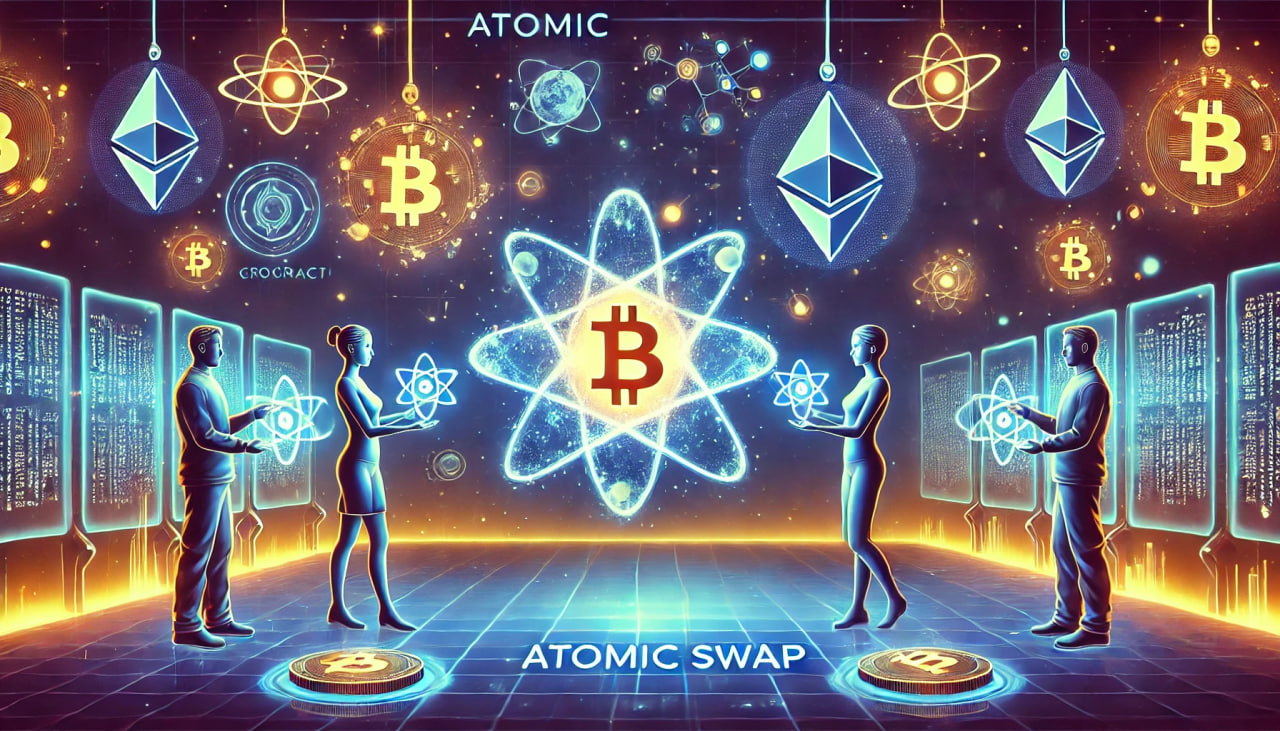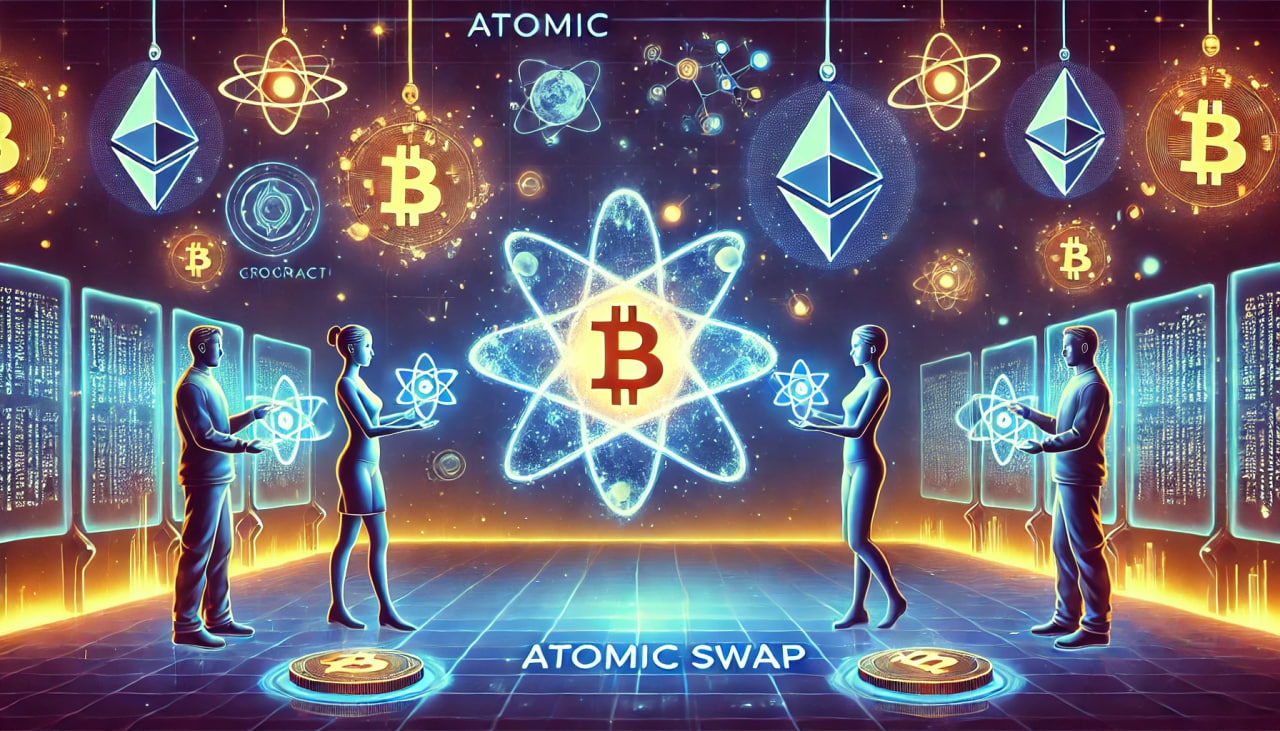In the era of rapid development of digital technologies and cryptocurrencies, the security and efficiency of financial operations are becoming priority tasks for market participants. One of the latest and most innovative solutions in this area is atomic swaps. These mechanisms, which ensure the direct exchange of cryptocurrencies between users without intermediaries, offer a revolutionary approach to decentralized trading of digital assets.
Atomic swaps, or atomic exchanges, allow users to exchange one cryptocurrency for another, bypassing centralized exchanges and eliminating the need to trust third parties. Based on smart contracts and cryptographic methods, this technology guarantees the security, transparency, and reliability of transactions, significantly reducing the risks of fraud and manipulation.

The Concept of Atomic Swap
To buy or sell cryptocurrency, centralized exchanges are usually used, which comes with a number of drawbacks: the need to trust the exchange, possible downtimes during high demand, and the exchange being subject to government regulation.
Atomic swaps allow direct trading between users through specially developed smart contracts for decentralized exchanges, offering a decentralized alternative to DEX with automatic marketmaker, like Uniswap, which rely on centralized liquidity pools. One of the most popular DEX based on atomic swaps is AtomicDEX, providing a system for trading cryptocurrencies with a peer-to-peer (p2p) order book.
Atomic swaps are based on hash time-locked contracts (HTLC), which include:
- A hashlock to lock and unlock the deposited currency.
- A timelock that returns the funds if the transaction is not completed on time.
Swaps ensure that both parties either receive the desired funds or the transaction is canceled and the funds are returned to the depositors, providing maximum security for digital asset trading.
Example of an Atomic Swap Operation:
- Party A creates an HTLC address, deposits cryptocurrency, and sends the hash to Party B.
- Party B uses the hash to generate an address and deposit their cryptocurrency.
- Party A uses the password to access Party B's coins.
- The contract sends the code to Party B, who then gains access to Party A's coins.
- If the time limit expires without completing the deal, the deposits are returned to the depositors.
Atomic swaps can be used to exchange cryptocurrencies both on the same blockchain and between different blockchains, such as Bitcoin and Ethereum, without the need to trust centralized exchanges. Off-chain swaps promise to improve transaction speed but are still under development.
How It Works
Atomic swaps operate using smart contracts and cryptographic "hashlock" technologies to ensure the security of digital asset exchanges.
The term "atomic" refers to processes that either complete successfully or do not start at all. In the case of an atomic swap for crypto trading, there are only two outcomes: either the deal completes successfully, or no action occurs.

Simply put, an atomic swap creates a mechanism where both parties must meet all pre-agreed conditions for the deal to be completed. This is achieved through smart contracts—self-executing programs that ensure the necessary conditions for a successful transaction are met.
For secure and non-custodial exchanges in the atomic swap system, hash time-locked contracts (HTLC) are used. These contracts lock the transaction and require both parties to verify the information before the exchange continues.
Smart contracts for atomic swaps consist of two main components:
| Mechanism | Description |
|---|---|
| Hashlock | The hashlock mechanism locks the contract with a unique cryptographic key that can only be generated by the cryptocurrency depositor. This key ensures that the swap will be completed only after the deal is approved by both parties. |
| Timelock | The timelock mechanism acts as a deadline for the swap. It ensures that the deal is completed within a specified time, and if this does not happen, the funds are returned to the sender. Timelock helps secure the deal by requiring approval from both parties within the specified period; otherwise, the cryptocurrency is returned to its owners. |
Atomic swaps represent an innovative method of exchanging cryptocurrencies, providing security and reliability of transactions without the need to trust centralized exchanges or intermediaries. The use of smart contracts with hashlock and timelock mechanisms guarantees that transactions will be completed only when all conditions are met, minimizing risks and increasing trust between parties.
Why Are Atomic Swaps Needed?
Atomic swaps facilitate the development of DeFi by eliminating inefficiencies characteristic of cryptocurrency exchanges within CeFi.
To exchange Ethereum (ETH) for Bitcoin (BTC), one can use centralized exchanges (CEX) like Binance, which requires the following steps:
- Registering an account and completing the KYC procedure.
- Transferring ETH to the exchange, paying a network fee, and waiting for transaction confirmation.
- Converting ETH to BTC.
- Withdrawing BTC to a Bitcoin wallet, paying a withdrawal fee, and waiting for confirmation.
This exchange process on a centralized exchange involves numerous actions, significant fees, and many potential complications. Additionally, using CEX may involve unforeseen security risks.
Atomic swaps, implemented within DeFi and DEX (decentralized exchanges), offer a safer and more efficient method of cryptocurrency exchange. They eliminate the need for intermediaries, simplify the trading process, and significantly reduce the number of potential security risk points. Thanks to smart contracts and cryptographic hashlock technologies, atomic swaps provide a direct and secure exchange of digital assets between users. This method not only makes the exchange process more economical but also gives users greater confidence in the safety of their funds, eliminating risks associated with centralized storage and control over private keys.
Advantages and Disadvantages
Atomic swaps, as an innovative technology in the cryptocurrency field, open up new possibilities for decentralized and secure digital asset exchanges. Despite their significant potential and numerous advantages, they also have several disadvantages that may limit their application. Below is a table of the advantages and disadvantages of atomic swaps:
| Advantages | Disadvantages |
|---|---|
| Fully decentralized nature: Peer-to-peer trading ensures autonomy and independence from centralized exchanges (CEX) and centralized liquidity pools. | Complexity of trading swaps: Requires the exchange of data, information, and hashed cryptograms, which can be challenging for novice traders. |
| Increased security: Hashlock and timelock mechanisms in smart contracts ensure the return of cryptocurrency in case of delays or disagreements. | Absence of fiat-crypto direction: Atomic swaps do not allow the exchange of fiat for cryptocurrency and vice versa. |
| Interoperability and flexibility in altcoin trading: The ability to exchange cryptocurrencies across different blockchains, solving the problem of limited altcoin selection on CEX. | Limited platform support: Few platforms support atomic swaps, and their use may require special programming skills and knowledge of hash functions. |
With the development of technology and the integration of atomic swaps into cryptocurrency wallets, they may become more accessible and widespread.
Atomic swaps represent a significant achievement in decentralized finance (DeFi), offering traders a secure and efficient way to exchange cryptocurrencies without the need to trust centralized exchanges. By using smart contracts with hashlock and timelock mechanisms, they ensure a high level of security and guarantee the fulfillment of all transaction conditions.
Overall, atomic swaps are a promising tool for the cryptocurrency market. With the advancement of technology and the expansion of support on various platforms, they may become an integral part of the digital asset ecosystem, providing users with safer and more decentralized trading methods.



